SHR018-2 HRM Case Study: Analyzing Ulrich, McKinsey, Ethics at ENH
VerifiedAdded on 2023/06/05
|10
|3208
|346
Case Study
AI Summary
This case study delves into the Human Resource Management practices at Electrical Network Holdings (ENH), a company employing over 50,000 individuals. It begins by comparing the Ulrich HR model and the McKinsey 7S model, evaluating their suitability for organizations. The study then explores ENH's journey towards becoming a more ethical company, emphasizing the role of Corporate Social Responsibility (CSR), transparency, and health and safety initiatives. Finally, it discusses strategies to improve employee engagement, addressing the challenges arising from a poor relationship between the workforce and HR, including flexible working arrangements, financial benefits, and timely promotions. The analysis aims to provide insights into effective HRM strategies for ENH and similar organizations.
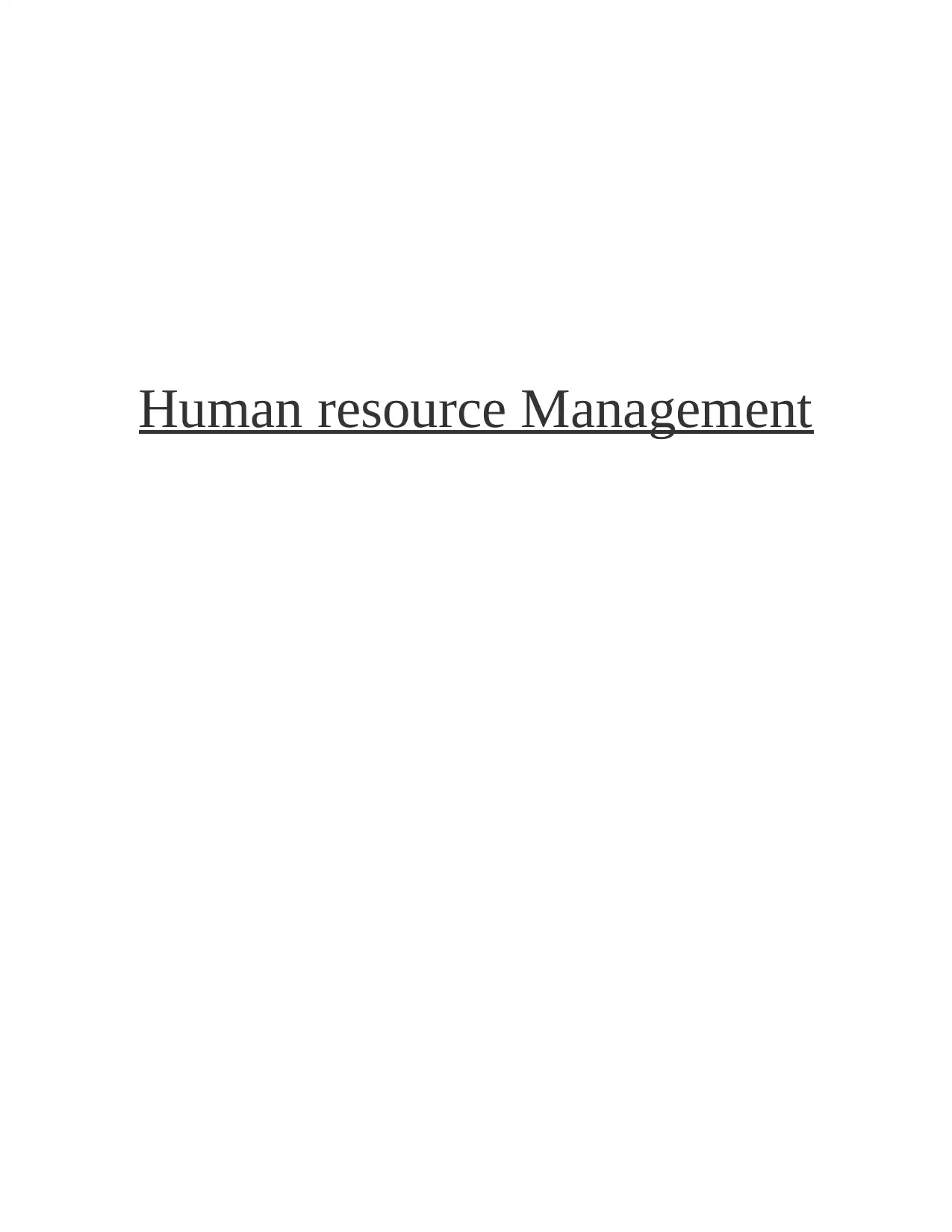
Human resource Management
Paraphrase This Document
Need a fresh take? Get an instant paraphrase of this document with our AI Paraphraser
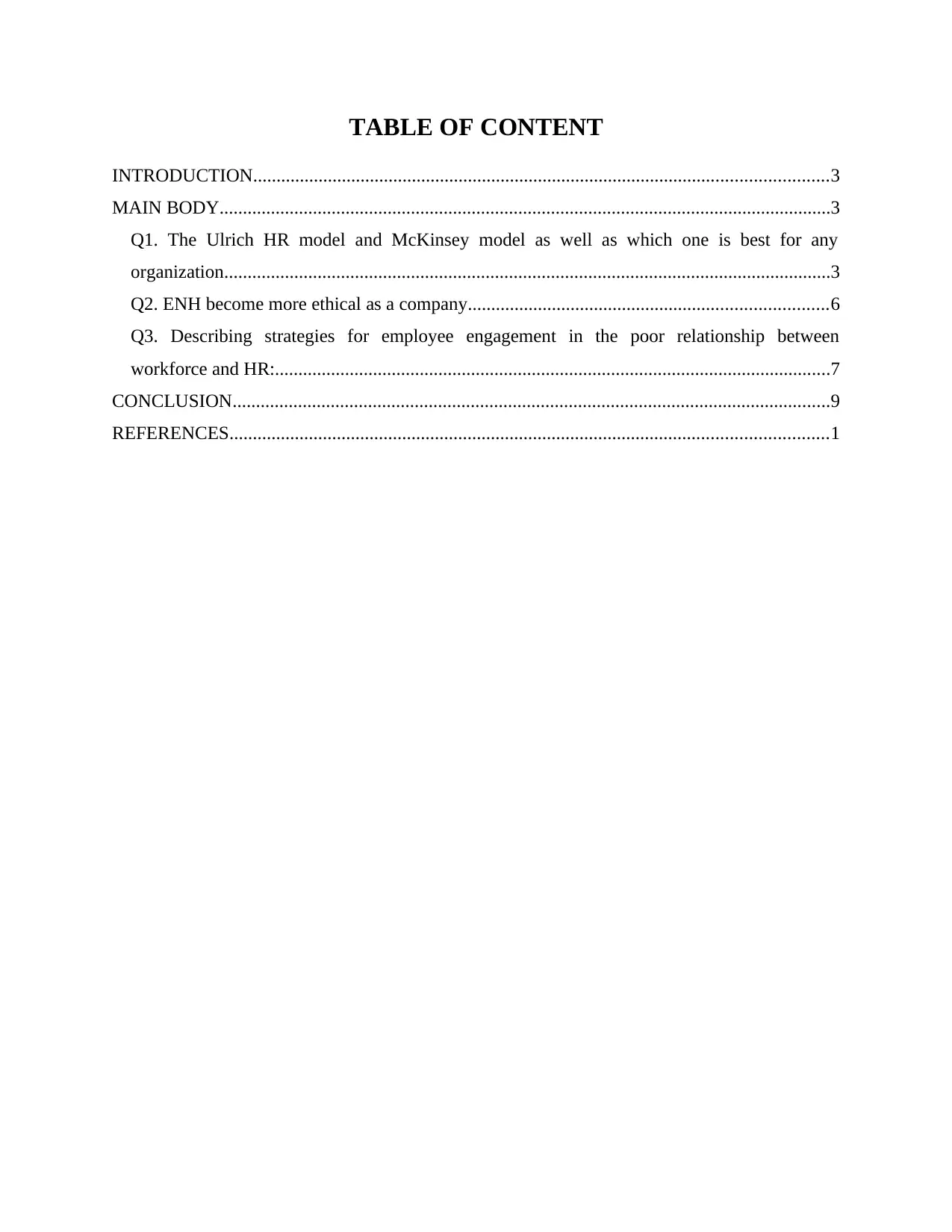
TABLE OF CONTENT
INTRODUCTION...........................................................................................................................3
MAIN BODY...................................................................................................................................3
Q1. The Ulrich HR model and McKinsey model as well as which one is best for any
organization..................................................................................................................................3
Q2. ENH become more ethical as a company.............................................................................6
Q3. Describing strategies for employee engagement in the poor relationship between
workforce and HR:.......................................................................................................................7
CONCLUSION................................................................................................................................9
REFERENCES................................................................................................................................1
INTRODUCTION...........................................................................................................................3
MAIN BODY...................................................................................................................................3
Q1. The Ulrich HR model and McKinsey model as well as which one is best for any
organization..................................................................................................................................3
Q2. ENH become more ethical as a company.............................................................................6
Q3. Describing strategies for employee engagement in the poor relationship between
workforce and HR:.......................................................................................................................7
CONCLUSION................................................................................................................................9
REFERENCES................................................................................................................................1
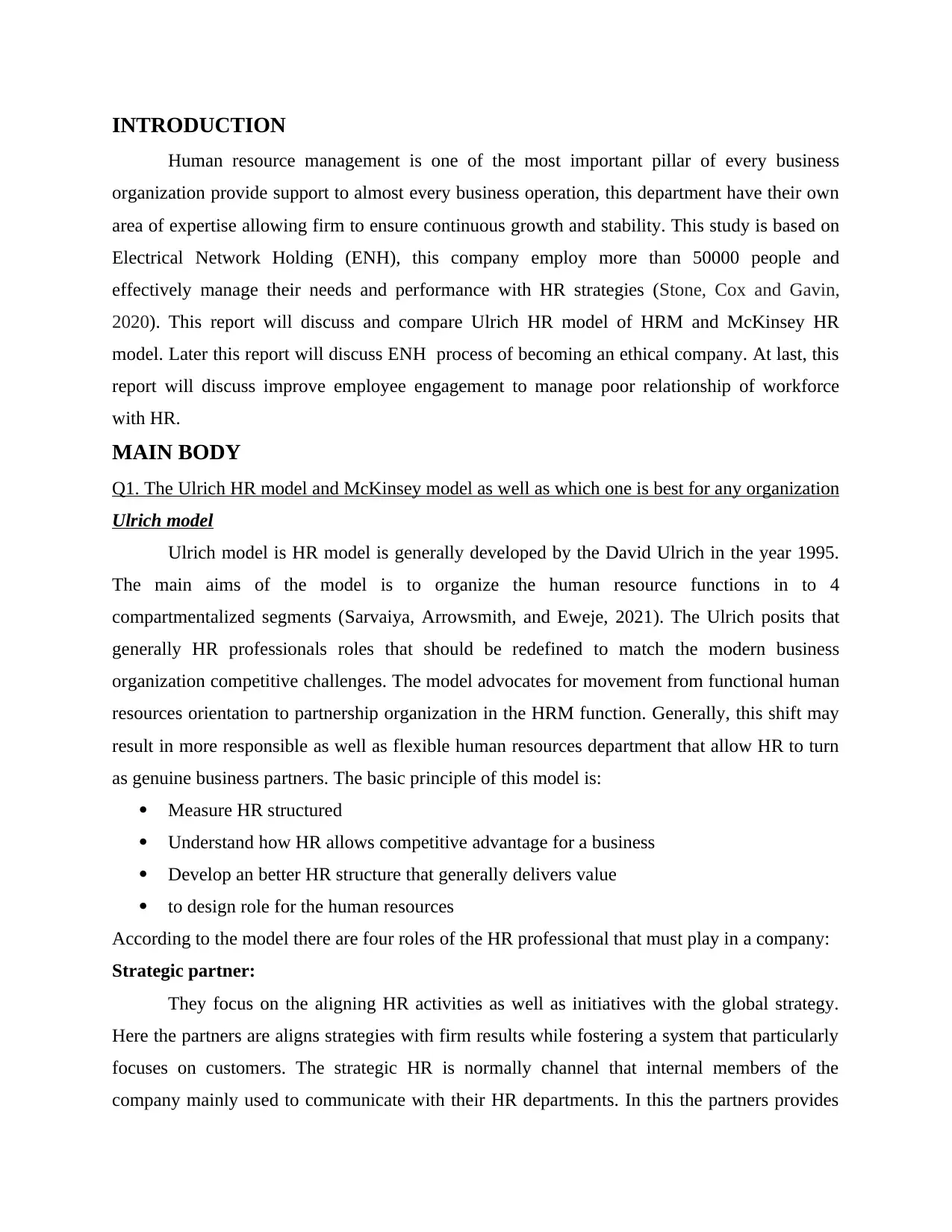
INTRODUCTION
Human resource management is one of the most important pillar of every business
organization provide support to almost every business operation, this department have their own
area of expertise allowing firm to ensure continuous growth and stability. This study is based on
Electrical Network Holding (ENH), this company employ more than 50000 people and
effectively manage their needs and performance with HR strategies (Stone, Cox and Gavin,
2020). This report will discuss and compare Ulrich HR model of HRM and McKinsey HR
model. Later this report will discuss ENH process of becoming an ethical company. At last, this
report will discuss improve employee engagement to manage poor relationship of workforce
with HR.
MAIN BODY
Q1. The Ulrich HR model and McKinsey model as well as which one is best for any organization
Ulrich model
Ulrich model is HR model is generally developed by the David Ulrich in the year 1995.
The main aims of the model is to organize the human resource functions in to 4
compartmentalized segments (Sarvaiya, Arrowsmith, and Eweje, 2021). The Ulrich posits that
generally HR professionals roles that should be redefined to match the modern business
organization competitive challenges. The model advocates for movement from functional human
resources orientation to partnership organization in the HRM function. Generally, this shift may
result in more responsible as well as flexible human resources department that allow HR to turn
as genuine business partners. The basic principle of this model is:
Measure HR structured
Understand how HR allows competitive advantage for a business
Develop an better HR structure that generally delivers value
to design role for the human resources
According to the model there are four roles of the HR professional that must play in a company:
Strategic partner:
They focus on the aligning HR activities as well as initiatives with the global strategy.
Here the partners are aligns strategies with firm results while fostering a system that particularly
focuses on customers. The strategic HR is normally channel that internal members of the
company mainly used to communicate with their HR departments. In this the partners provides
Human resource management is one of the most important pillar of every business
organization provide support to almost every business operation, this department have their own
area of expertise allowing firm to ensure continuous growth and stability. This study is based on
Electrical Network Holding (ENH), this company employ more than 50000 people and
effectively manage their needs and performance with HR strategies (Stone, Cox and Gavin,
2020). This report will discuss and compare Ulrich HR model of HRM and McKinsey HR
model. Later this report will discuss ENH process of becoming an ethical company. At last, this
report will discuss improve employee engagement to manage poor relationship of workforce
with HR.
MAIN BODY
Q1. The Ulrich HR model and McKinsey model as well as which one is best for any organization
Ulrich model
Ulrich model is HR model is generally developed by the David Ulrich in the year 1995.
The main aims of the model is to organize the human resource functions in to 4
compartmentalized segments (Sarvaiya, Arrowsmith, and Eweje, 2021). The Ulrich posits that
generally HR professionals roles that should be redefined to match the modern business
organization competitive challenges. The model advocates for movement from functional human
resources orientation to partnership organization in the HRM function. Generally, this shift may
result in more responsible as well as flexible human resources department that allow HR to turn
as genuine business partners. The basic principle of this model is:
Measure HR structured
Understand how HR allows competitive advantage for a business
Develop an better HR structure that generally delivers value
to design role for the human resources
According to the model there are four roles of the HR professional that must play in a company:
Strategic partner:
They focus on the aligning HR activities as well as initiatives with the global strategy.
Here the partners are aligns strategies with firm results while fostering a system that particularly
focuses on customers. The strategic HR is normally channel that internal members of the
company mainly used to communicate with their HR departments. In this the partners provides
⊘ This is a preview!⊘
Do you want full access?
Subscribe today to unlock all pages.

Trusted by 1+ million students worldwide
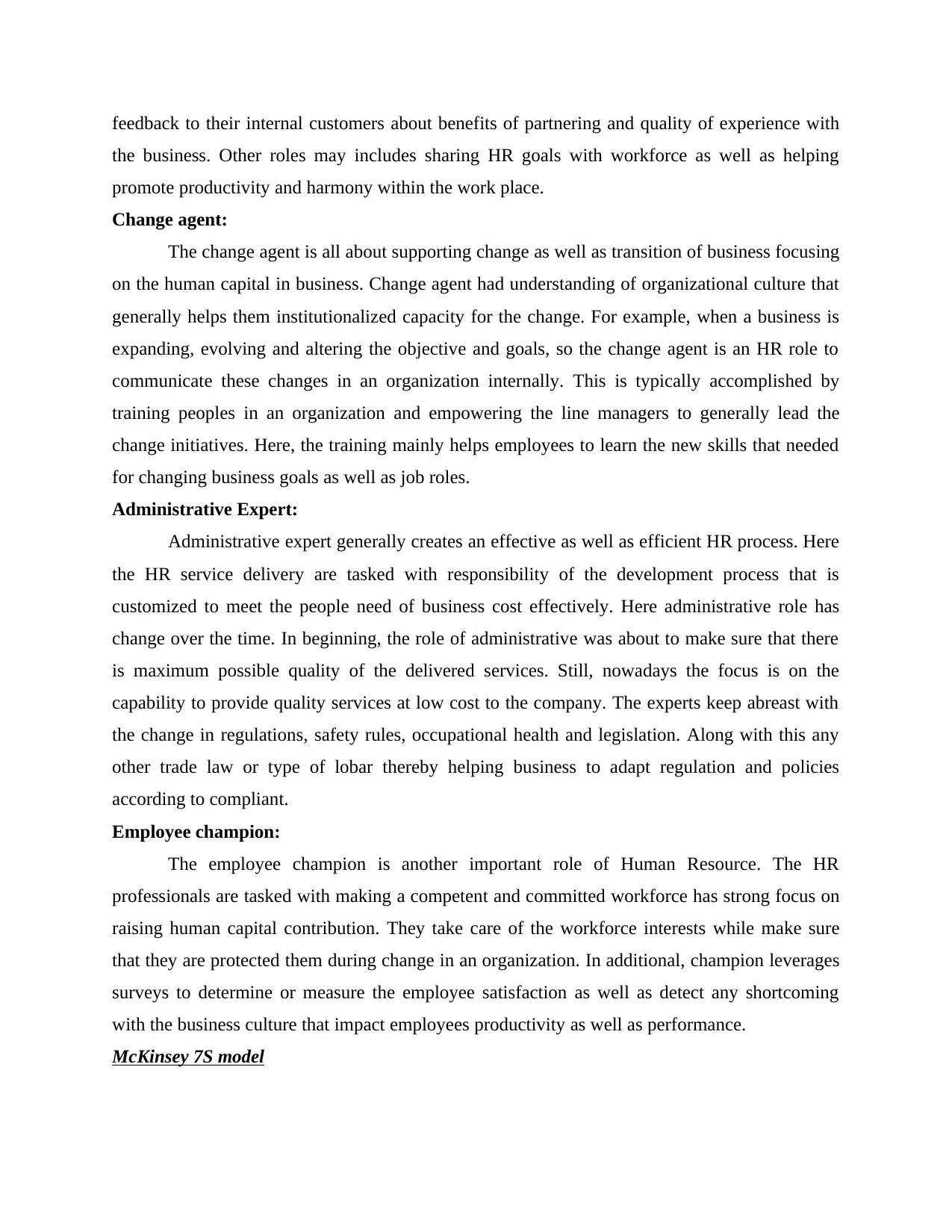
feedback to their internal customers about benefits of partnering and quality of experience with
the business. Other roles may includes sharing HR goals with workforce as well as helping
promote productivity and harmony within the work place.
Change agent:
The change agent is all about supporting change as well as transition of business focusing
on the human capital in business. Change agent had understanding of organizational culture that
generally helps them institutionalized capacity for the change. For example, when a business is
expanding, evolving and altering the objective and goals, so the change agent is an HR role to
communicate these changes in an organization internally. This is typically accomplished by
training peoples in an organization and empowering the line managers to generally lead the
change initiatives. Here, the training mainly helps employees to learn the new skills that needed
for changing business goals as well as job roles.
Administrative Expert:
Administrative expert generally creates an effective as well as efficient HR process. Here
the HR service delivery are tasked with responsibility of the development process that is
customized to meet the people need of business cost effectively. Here administrative role has
change over the time. In beginning, the role of administrative was about to make sure that there
is maximum possible quality of the delivered services. Still, nowadays the focus is on the
capability to provide quality services at low cost to the company. The experts keep abreast with
the change in regulations, safety rules, occupational health and legislation. Along with this any
other trade law or type of lobar thereby helping business to adapt regulation and policies
according to compliant.
Employee champion:
The employee champion is another important role of Human Resource. The HR
professionals are tasked with making a competent and committed workforce has strong focus on
raising human capital contribution. They take care of the workforce interests while make sure
that they are protected them during change in an organization. In additional, champion leverages
surveys to determine or measure the employee satisfaction as well as detect any shortcoming
with the business culture that impact employees productivity as well as performance.
McKinsey 7S model
the business. Other roles may includes sharing HR goals with workforce as well as helping
promote productivity and harmony within the work place.
Change agent:
The change agent is all about supporting change as well as transition of business focusing
on the human capital in business. Change agent had understanding of organizational culture that
generally helps them institutionalized capacity for the change. For example, when a business is
expanding, evolving and altering the objective and goals, so the change agent is an HR role to
communicate these changes in an organization internally. This is typically accomplished by
training peoples in an organization and empowering the line managers to generally lead the
change initiatives. Here, the training mainly helps employees to learn the new skills that needed
for changing business goals as well as job roles.
Administrative Expert:
Administrative expert generally creates an effective as well as efficient HR process. Here
the HR service delivery are tasked with responsibility of the development process that is
customized to meet the people need of business cost effectively. Here administrative role has
change over the time. In beginning, the role of administrative was about to make sure that there
is maximum possible quality of the delivered services. Still, nowadays the focus is on the
capability to provide quality services at low cost to the company. The experts keep abreast with
the change in regulations, safety rules, occupational health and legislation. Along with this any
other trade law or type of lobar thereby helping business to adapt regulation and policies
according to compliant.
Employee champion:
The employee champion is another important role of Human Resource. The HR
professionals are tasked with making a competent and committed workforce has strong focus on
raising human capital contribution. They take care of the workforce interests while make sure
that they are protected them during change in an organization. In additional, champion leverages
surveys to determine or measure the employee satisfaction as well as detect any shortcoming
with the business culture that impact employees productivity as well as performance.
McKinsey 7S model
Paraphrase This Document
Need a fresh take? Get an instant paraphrase of this document with our AI Paraphraser
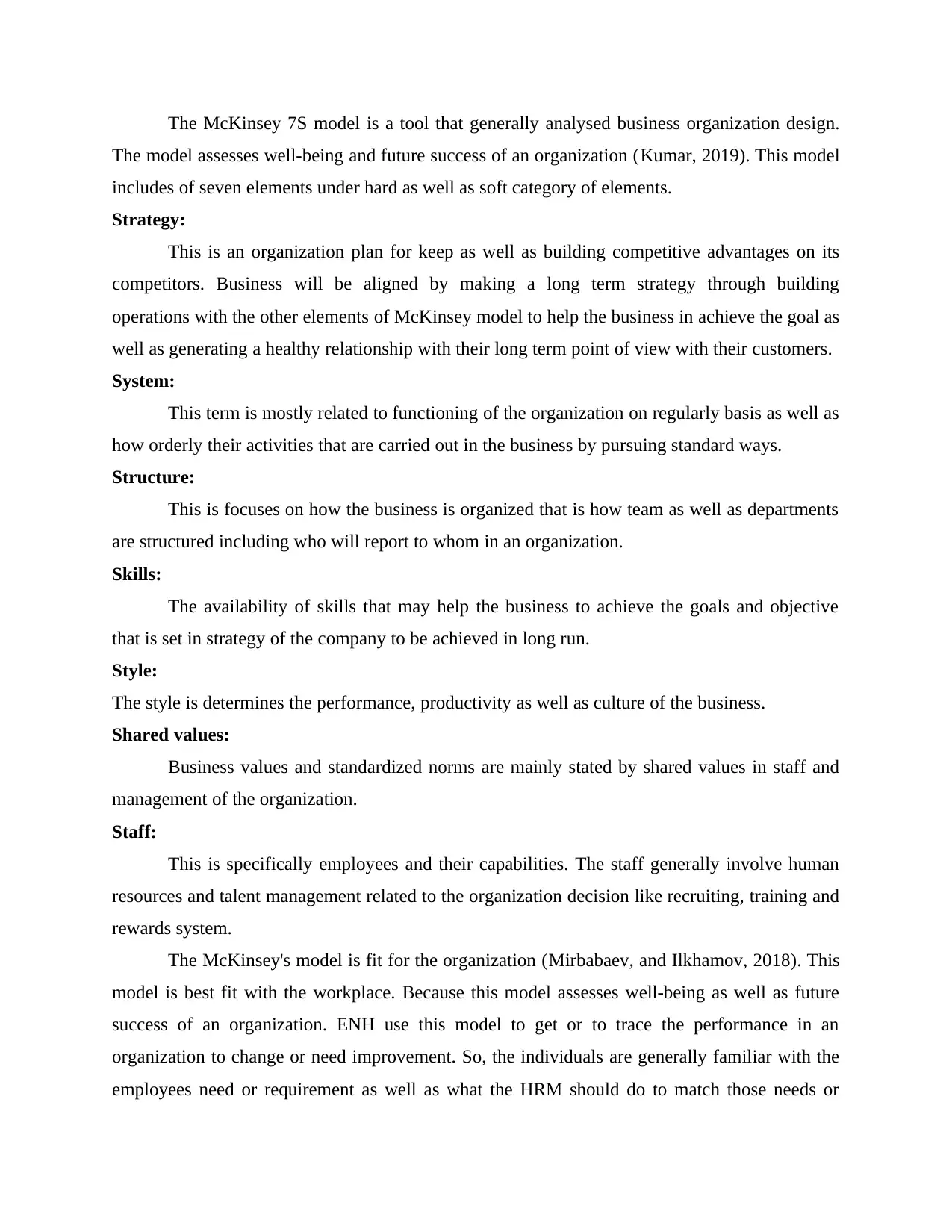
The McKinsey 7S model is a tool that generally analysed business organization design.
The model assesses well-being and future success of an organization (Kumar, 2019). This model
includes of seven elements under hard as well as soft category of elements.
Strategy:
This is an organization plan for keep as well as building competitive advantages on its
competitors. Business will be aligned by making a long term strategy through building
operations with the other elements of McKinsey model to help the business in achieve the goal as
well as generating a healthy relationship with their long term point of view with their customers.
System:
This term is mostly related to functioning of the organization on regularly basis as well as
how orderly their activities that are carried out in the business by pursuing standard ways.
Structure:
This is focuses on how the business is organized that is how team as well as departments
are structured including who will report to whom in an organization.
Skills:
The availability of skills that may help the business to achieve the goals and objective
that is set in strategy of the company to be achieved in long run.
Style:
The style is determines the performance, productivity as well as culture of the business.
Shared values:
Business values and standardized norms are mainly stated by shared values in staff and
management of the organization.
Staff:
This is specifically employees and their capabilities. The staff generally involve human
resources and talent management related to the organization decision like recruiting, training and
rewards system.
The McKinsey's model is fit for the organization (Mirbabaev, and Ilkhamov, 2018). This
model is best fit with the workplace. Because this model assesses well-being as well as future
success of an organization. ENH use this model to get or to trace the performance in an
organization to change or need improvement. So, the individuals are generally familiar with the
employees need or requirement as well as what the HRM should do to match those needs or
The model assesses well-being and future success of an organization (Kumar, 2019). This model
includes of seven elements under hard as well as soft category of elements.
Strategy:
This is an organization plan for keep as well as building competitive advantages on its
competitors. Business will be aligned by making a long term strategy through building
operations with the other elements of McKinsey model to help the business in achieve the goal as
well as generating a healthy relationship with their long term point of view with their customers.
System:
This term is mostly related to functioning of the organization on regularly basis as well as
how orderly their activities that are carried out in the business by pursuing standard ways.
Structure:
This is focuses on how the business is organized that is how team as well as departments
are structured including who will report to whom in an organization.
Skills:
The availability of skills that may help the business to achieve the goals and objective
that is set in strategy of the company to be achieved in long run.
Style:
The style is determines the performance, productivity as well as culture of the business.
Shared values:
Business values and standardized norms are mainly stated by shared values in staff and
management of the organization.
Staff:
This is specifically employees and their capabilities. The staff generally involve human
resources and talent management related to the organization decision like recruiting, training and
rewards system.
The McKinsey's model is fit for the organization (Mirbabaev, and Ilkhamov, 2018). This
model is best fit with the workplace. Because this model assesses well-being as well as future
success of an organization. ENH use this model to get or to trace the performance in an
organization to change or need improvement. So, the individuals are generally familiar with the
employees need or requirement as well as what the HRM should do to match those needs or
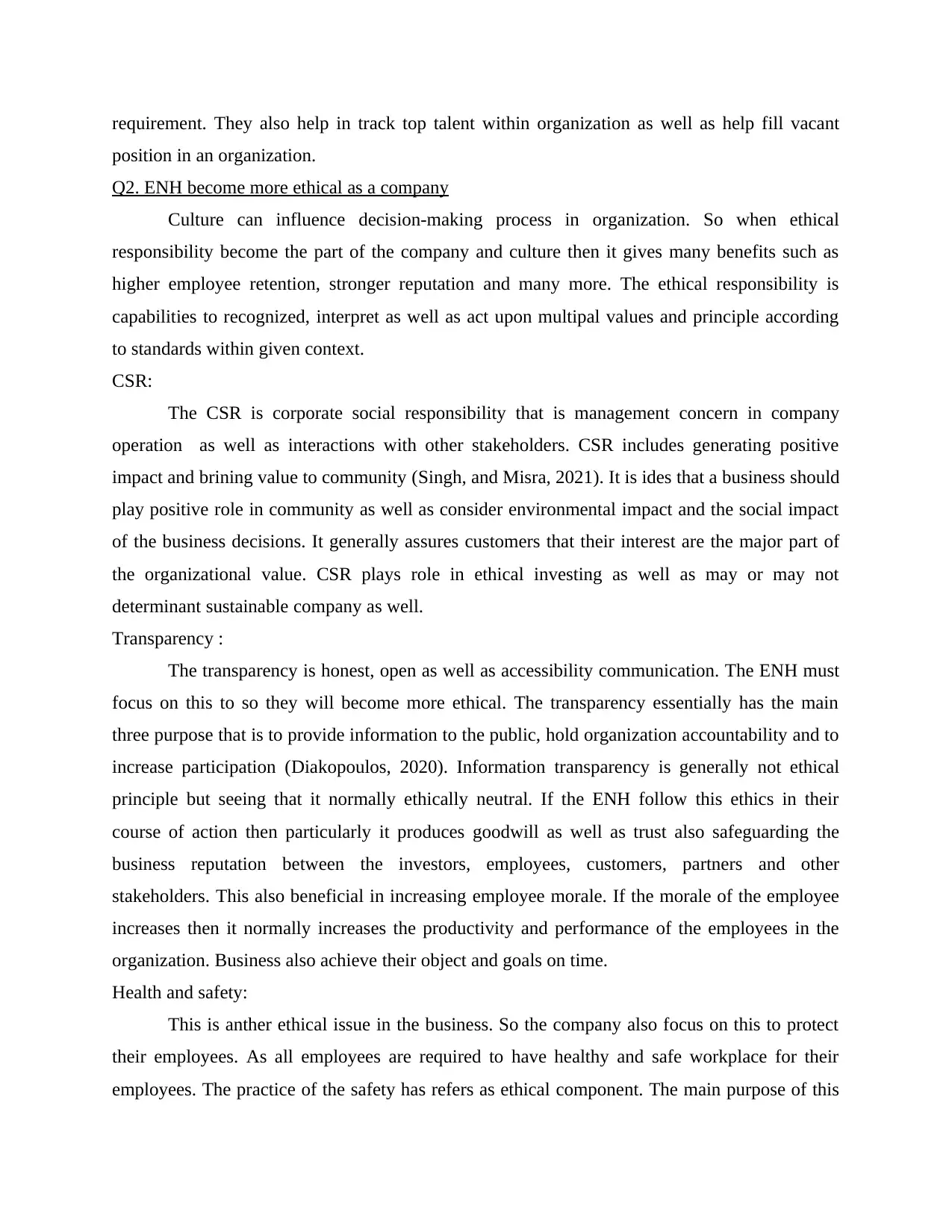
requirement. They also help in track top talent within organization as well as help fill vacant
position in an organization.
Q2. ENH become more ethical as a company
Culture can influence decision-making process in organization. So when ethical
responsibility become the part of the company and culture then it gives many benefits such as
higher employee retention, stronger reputation and many more. The ethical responsibility is
capabilities to recognized, interpret as well as act upon multipal values and principle according
to standards within given context.
CSR:
The CSR is corporate social responsibility that is management concern in company
operation as well as interactions with other stakeholders. CSR includes generating positive
impact and brining value to community (Singh, and Misra, 2021). It is ides that a business should
play positive role in community as well as consider environmental impact and the social impact
of the business decisions. It generally assures customers that their interest are the major part of
the organizational value. CSR plays role in ethical investing as well as may or may not
determinant sustainable company as well.
Transparency :
The transparency is honest, open as well as accessibility communication. The ENH must
focus on this to so they will become more ethical. The transparency essentially has the main
three purpose that is to provide information to the public, hold organization accountability and to
increase participation (Diakopoulos, 2020). Information transparency is generally not ethical
principle but seeing that it normally ethically neutral. If the ENH follow this ethics in their
course of action then particularly it produces goodwill as well as trust also safeguarding the
business reputation between the investors, employees, customers, partners and other
stakeholders. This also beneficial in increasing employee morale. If the morale of the employee
increases then it normally increases the productivity and performance of the employees in the
organization. Business also achieve their object and goals on time.
Health and safety:
This is anther ethical issue in the business. So the company also focus on this to protect
their employees. As all employees are required to have healthy and safe workplace for their
employees. The practice of the safety has refers as ethical component. The main purpose of this
position in an organization.
Q2. ENH become more ethical as a company
Culture can influence decision-making process in organization. So when ethical
responsibility become the part of the company and culture then it gives many benefits such as
higher employee retention, stronger reputation and many more. The ethical responsibility is
capabilities to recognized, interpret as well as act upon multipal values and principle according
to standards within given context.
CSR:
The CSR is corporate social responsibility that is management concern in company
operation as well as interactions with other stakeholders. CSR includes generating positive
impact and brining value to community (Singh, and Misra, 2021). It is ides that a business should
play positive role in community as well as consider environmental impact and the social impact
of the business decisions. It generally assures customers that their interest are the major part of
the organizational value. CSR plays role in ethical investing as well as may or may not
determinant sustainable company as well.
Transparency :
The transparency is honest, open as well as accessibility communication. The ENH must
focus on this to so they will become more ethical. The transparency essentially has the main
three purpose that is to provide information to the public, hold organization accountability and to
increase participation (Diakopoulos, 2020). Information transparency is generally not ethical
principle but seeing that it normally ethically neutral. If the ENH follow this ethics in their
course of action then particularly it produces goodwill as well as trust also safeguarding the
business reputation between the investors, employees, customers, partners and other
stakeholders. This also beneficial in increasing employee morale. If the morale of the employee
increases then it normally increases the productivity and performance of the employees in the
organization. Business also achieve their object and goals on time.
Health and safety:
This is anther ethical issue in the business. So the company also focus on this to protect
their employees. As all employees are required to have healthy and safe workplace for their
employees. The practice of the safety has refers as ethical component. The main purpose of this
⊘ This is a preview!⊘
Do you want full access?
Subscribe today to unlock all pages.

Trusted by 1+ million students worldwide
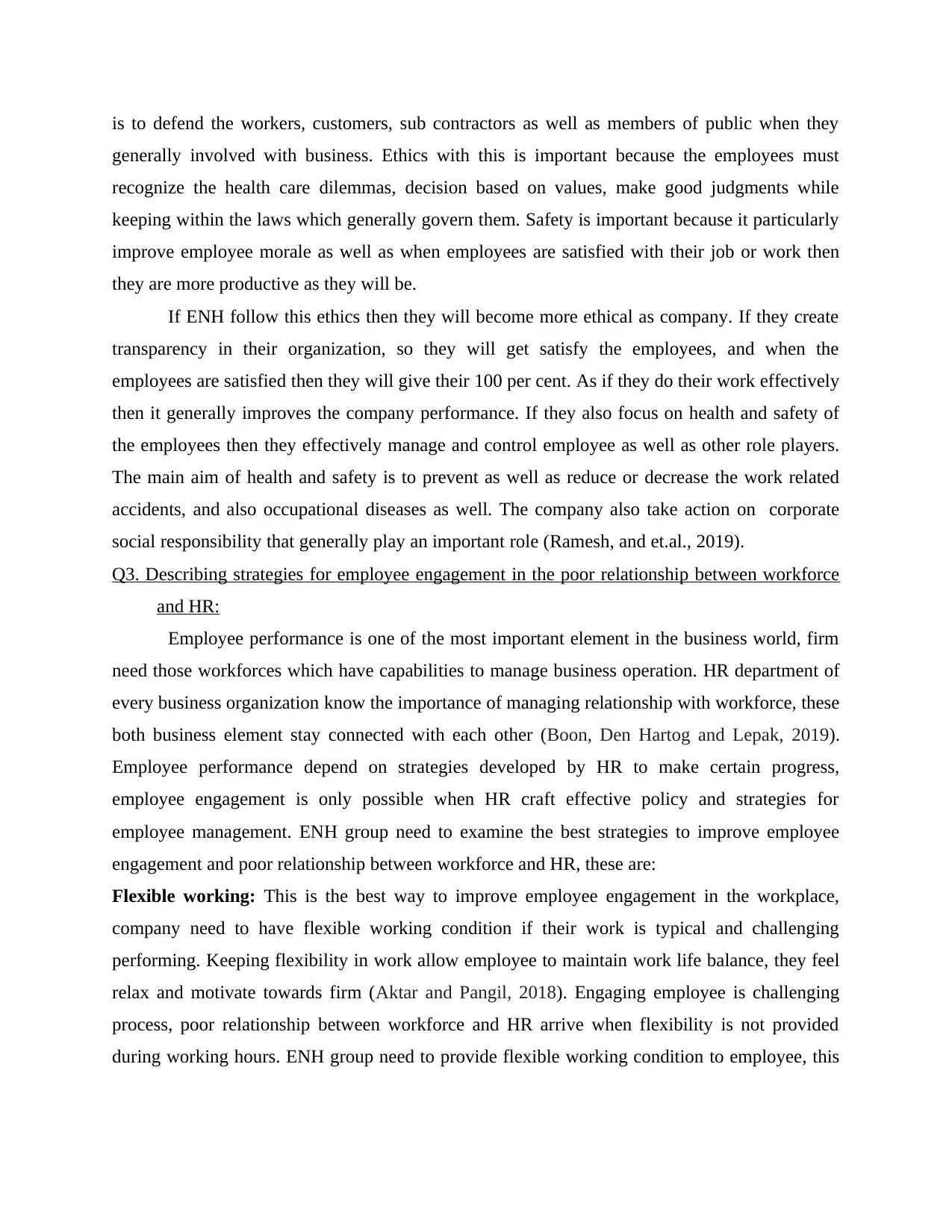
is to defend the workers, customers, sub contractors as well as members of public when they
generally involved with business. Ethics with this is important because the employees must
recognize the health care dilemmas, decision based on values, make good judgments while
keeping within the laws which generally govern them. Safety is important because it particularly
improve employee morale as well as when employees are satisfied with their job or work then
they are more productive as they will be.
If ENH follow this ethics then they will become more ethical as company. If they create
transparency in their organization, so they will get satisfy the employees, and when the
employees are satisfied then they will give their 100 per cent. As if they do their work effectively
then it generally improves the company performance. If they also focus on health and safety of
the employees then they effectively manage and control employee as well as other role players.
The main aim of health and safety is to prevent as well as reduce or decrease the work related
accidents, and also occupational diseases as well. The company also take action on corporate
social responsibility that generally play an important role (Ramesh, and et.al., 2019).
Q3. Describing strategies for employee engagement in the poor relationship between workforce
and HR:
Employee performance is one of the most important element in the business world, firm
need those workforces which have capabilities to manage business operation. HR department of
every business organization know the importance of managing relationship with workforce, these
both business element stay connected with each other (Boon, Den Hartog and Lepak, 2019).
Employee performance depend on strategies developed by HR to make certain progress,
employee engagement is only possible when HR craft effective policy and strategies for
employee management. ENH group need to examine the best strategies to improve employee
engagement and poor relationship between workforce and HR, these are:
Flexible working: This is the best way to improve employee engagement in the workplace,
company need to have flexible working condition if their work is typical and challenging
performing. Keeping flexibility in work allow employee to maintain work life balance, they feel
relax and motivate towards firm (Aktar and Pangil, 2018). Engaging employee is challenging
process, poor relationship between workforce and HR arrive when flexibility is not provided
during working hours. ENH group need to provide flexible working condition to employee, this
generally involved with business. Ethics with this is important because the employees must
recognize the health care dilemmas, decision based on values, make good judgments while
keeping within the laws which generally govern them. Safety is important because it particularly
improve employee morale as well as when employees are satisfied with their job or work then
they are more productive as they will be.
If ENH follow this ethics then they will become more ethical as company. If they create
transparency in their organization, so they will get satisfy the employees, and when the
employees are satisfied then they will give their 100 per cent. As if they do their work effectively
then it generally improves the company performance. If they also focus on health and safety of
the employees then they effectively manage and control employee as well as other role players.
The main aim of health and safety is to prevent as well as reduce or decrease the work related
accidents, and also occupational diseases as well. The company also take action on corporate
social responsibility that generally play an important role (Ramesh, and et.al., 2019).
Q3. Describing strategies for employee engagement in the poor relationship between workforce
and HR:
Employee performance is one of the most important element in the business world, firm
need those workforces which have capabilities to manage business operation. HR department of
every business organization know the importance of managing relationship with workforce, these
both business element stay connected with each other (Boon, Den Hartog and Lepak, 2019).
Employee performance depend on strategies developed by HR to make certain progress,
employee engagement is only possible when HR craft effective policy and strategies for
employee management. ENH group need to examine the best strategies to improve employee
engagement and poor relationship between workforce and HR, these are:
Flexible working: This is the best way to improve employee engagement in the workplace,
company need to have flexible working condition if their work is typical and challenging
performing. Keeping flexibility in work allow employee to maintain work life balance, they feel
relax and motivate towards firm (Aktar and Pangil, 2018). Engaging employee is challenging
process, poor relationship between workforce and HR arrive when flexibility is not provided
during working hours. ENH group need to provide flexible working condition to employee, this
Paraphrase This Document
Need a fresh take? Get an instant paraphrase of this document with our AI Paraphraser
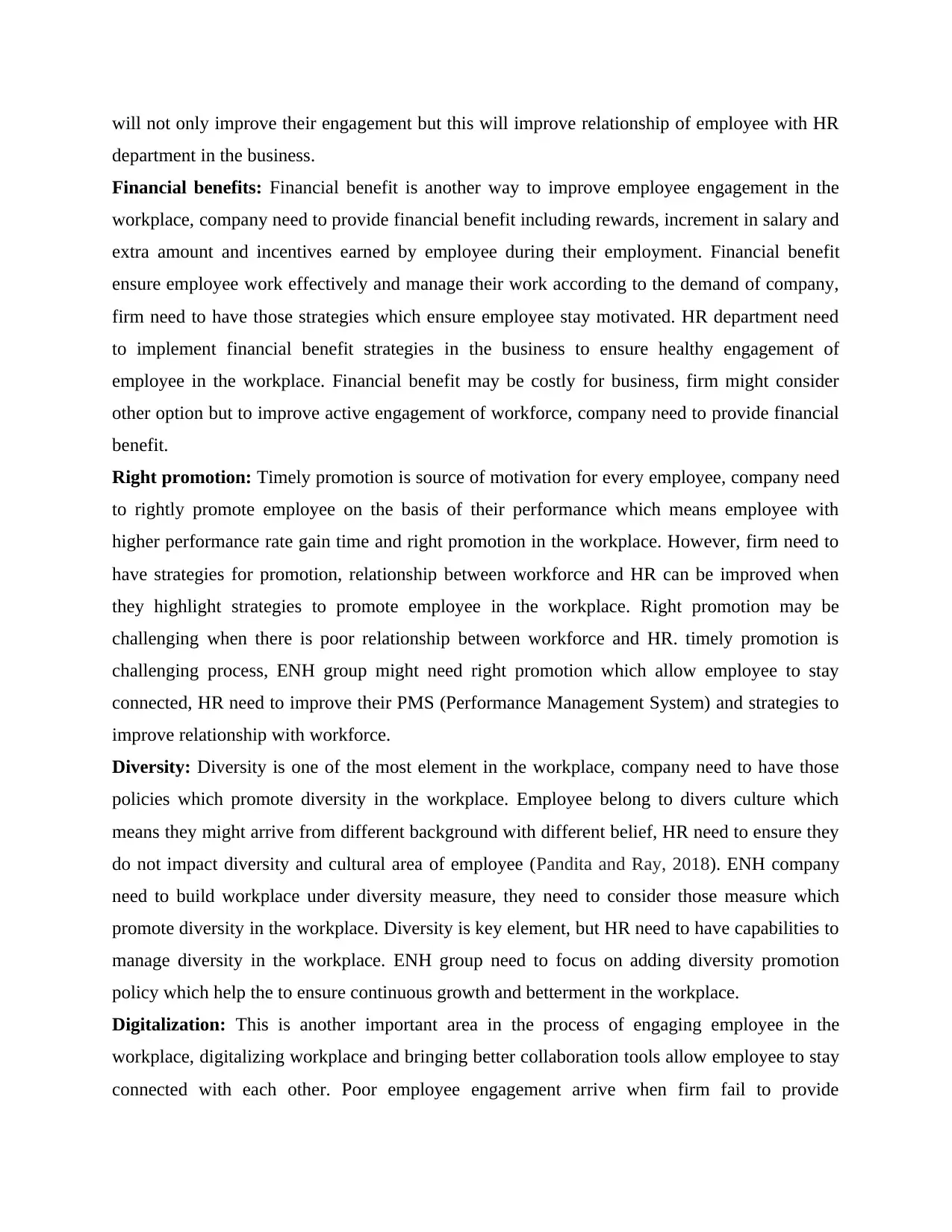
will not only improve their engagement but this will improve relationship of employee with HR
department in the business.
Financial benefits: Financial benefit is another way to improve employee engagement in the
workplace, company need to provide financial benefit including rewards, increment in salary and
extra amount and incentives earned by employee during their employment. Financial benefit
ensure employee work effectively and manage their work according to the demand of company,
firm need to have those strategies which ensure employee stay motivated. HR department need
to implement financial benefit strategies in the business to ensure healthy engagement of
employee in the workplace. Financial benefit may be costly for business, firm might consider
other option but to improve active engagement of workforce, company need to provide financial
benefit.
Right promotion: Timely promotion is source of motivation for every employee, company need
to rightly promote employee on the basis of their performance which means employee with
higher performance rate gain time and right promotion in the workplace. However, firm need to
have strategies for promotion, relationship between workforce and HR can be improved when
they highlight strategies to promote employee in the workplace. Right promotion may be
challenging when there is poor relationship between workforce and HR. timely promotion is
challenging process, ENH group might need right promotion which allow employee to stay
connected, HR need to improve their PMS (Performance Management System) and strategies to
improve relationship with workforce.
Diversity: Diversity is one of the most element in the workplace, company need to have those
policies which promote diversity in the workplace. Employee belong to divers culture which
means they might arrive from different background with different belief, HR need to ensure they
do not impact diversity and cultural area of employee (Pandita and Ray, 2018). ENH company
need to build workplace under diversity measure, they need to consider those measure which
promote diversity in the workplace. Diversity is key element, but HR need to have capabilities to
manage diversity in the workplace. ENH group need to focus on adding diversity promotion
policy which help the to ensure continuous growth and betterment in the workplace.
Digitalization: This is another important area in the process of engaging employee in the
workplace, digitalizing workplace and bringing better collaboration tools allow employee to stay
connected with each other. Poor employee engagement arrive when firm fail to provide
department in the business.
Financial benefits: Financial benefit is another way to improve employee engagement in the
workplace, company need to provide financial benefit including rewards, increment in salary and
extra amount and incentives earned by employee during their employment. Financial benefit
ensure employee work effectively and manage their work according to the demand of company,
firm need to have those strategies which ensure employee stay motivated. HR department need
to implement financial benefit strategies in the business to ensure healthy engagement of
employee in the workplace. Financial benefit may be costly for business, firm might consider
other option but to improve active engagement of workforce, company need to provide financial
benefit.
Right promotion: Timely promotion is source of motivation for every employee, company need
to rightly promote employee on the basis of their performance which means employee with
higher performance rate gain time and right promotion in the workplace. However, firm need to
have strategies for promotion, relationship between workforce and HR can be improved when
they highlight strategies to promote employee in the workplace. Right promotion may be
challenging when there is poor relationship between workforce and HR. timely promotion is
challenging process, ENH group might need right promotion which allow employee to stay
connected, HR need to improve their PMS (Performance Management System) and strategies to
improve relationship with workforce.
Diversity: Diversity is one of the most element in the workplace, company need to have those
policies which promote diversity in the workplace. Employee belong to divers culture which
means they might arrive from different background with different belief, HR need to ensure they
do not impact diversity and cultural area of employee (Pandita and Ray, 2018). ENH company
need to build workplace under diversity measure, they need to consider those measure which
promote diversity in the workplace. Diversity is key element, but HR need to have capabilities to
manage diversity in the workplace. ENH group need to focus on adding diversity promotion
policy which help the to ensure continuous growth and betterment in the workplace.
Digitalization: This is another important area in the process of engaging employee in the
workplace, digitalizing workplace and bringing better collaboration tools allow employee to stay
connected with each other. Poor employee engagement arrive when firm fail to provide
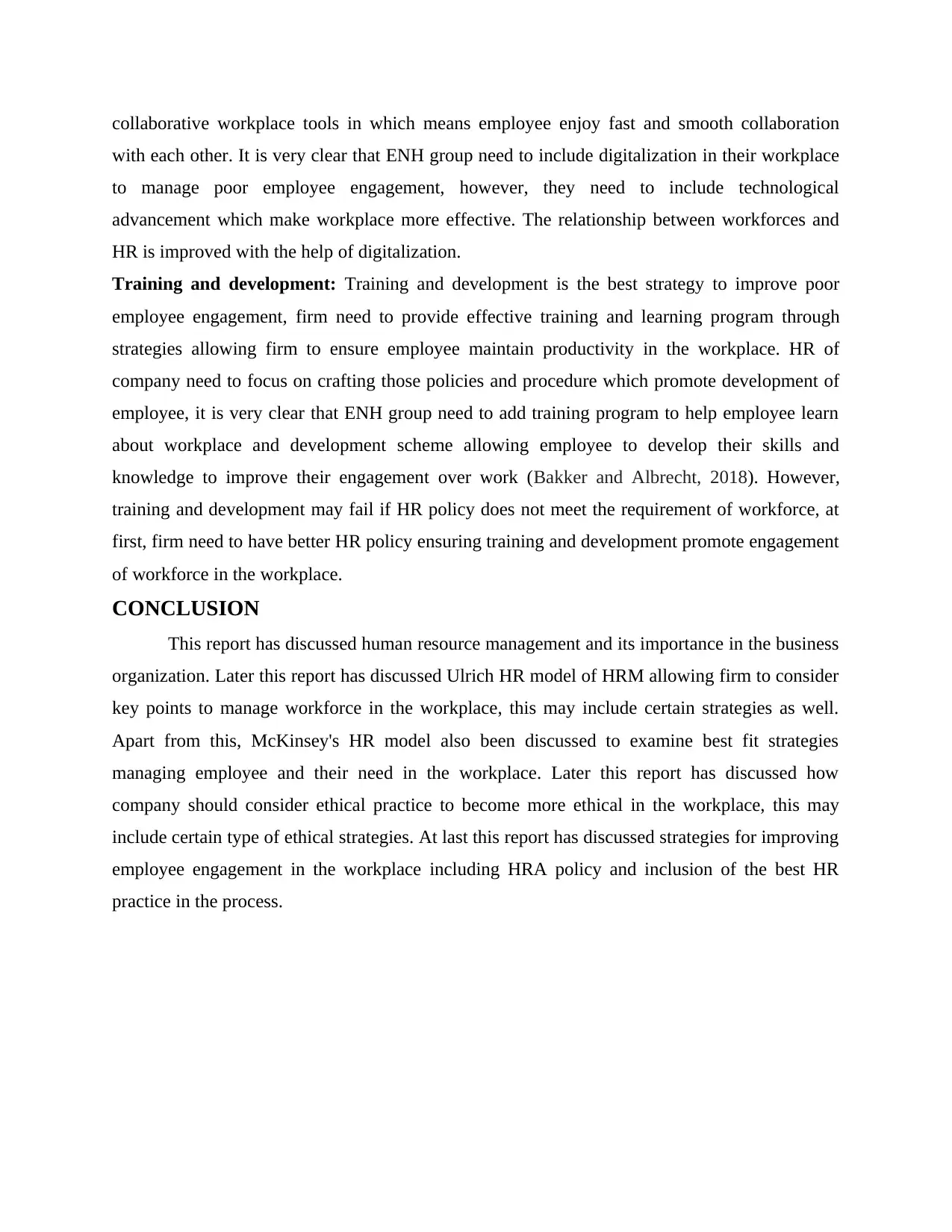
collaborative workplace tools in which means employee enjoy fast and smooth collaboration
with each other. It is very clear that ENH group need to include digitalization in their workplace
to manage poor employee engagement, however, they need to include technological
advancement which make workplace more effective. The relationship between workforces and
HR is improved with the help of digitalization.
Training and development: Training and development is the best strategy to improve poor
employee engagement, firm need to provide effective training and learning program through
strategies allowing firm to ensure employee maintain productivity in the workplace. HR of
company need to focus on crafting those policies and procedure which promote development of
employee, it is very clear that ENH group need to add training program to help employee learn
about workplace and development scheme allowing employee to develop their skills and
knowledge to improve their engagement over work (Bakker and Albrecht, 2018). However,
training and development may fail if HR policy does not meet the requirement of workforce, at
first, firm need to have better HR policy ensuring training and development promote engagement
of workforce in the workplace.
CONCLUSION
This report has discussed human resource management and its importance in the business
organization. Later this report has discussed Ulrich HR model of HRM allowing firm to consider
key points to manage workforce in the workplace, this may include certain strategies as well.
Apart from this, McKinsey's HR model also been discussed to examine best fit strategies
managing employee and their need in the workplace. Later this report has discussed how
company should consider ethical practice to become more ethical in the workplace, this may
include certain type of ethical strategies. At last this report has discussed strategies for improving
employee engagement in the workplace including HRA policy and inclusion of the best HR
practice in the process.
with each other. It is very clear that ENH group need to include digitalization in their workplace
to manage poor employee engagement, however, they need to include technological
advancement which make workplace more effective. The relationship between workforces and
HR is improved with the help of digitalization.
Training and development: Training and development is the best strategy to improve poor
employee engagement, firm need to provide effective training and learning program through
strategies allowing firm to ensure employee maintain productivity in the workplace. HR of
company need to focus on crafting those policies and procedure which promote development of
employee, it is very clear that ENH group need to add training program to help employee learn
about workplace and development scheme allowing employee to develop their skills and
knowledge to improve their engagement over work (Bakker and Albrecht, 2018). However,
training and development may fail if HR policy does not meet the requirement of workforce, at
first, firm need to have better HR policy ensuring training and development promote engagement
of workforce in the workplace.
CONCLUSION
This report has discussed human resource management and its importance in the business
organization. Later this report has discussed Ulrich HR model of HRM allowing firm to consider
key points to manage workforce in the workplace, this may include certain strategies as well.
Apart from this, McKinsey's HR model also been discussed to examine best fit strategies
managing employee and their need in the workplace. Later this report has discussed how
company should consider ethical practice to become more ethical in the workplace, this may
include certain type of ethical strategies. At last this report has discussed strategies for improving
employee engagement in the workplace including HRA policy and inclusion of the best HR
practice in the process.
⊘ This is a preview!⊘
Do you want full access?
Subscribe today to unlock all pages.

Trusted by 1+ million students worldwide
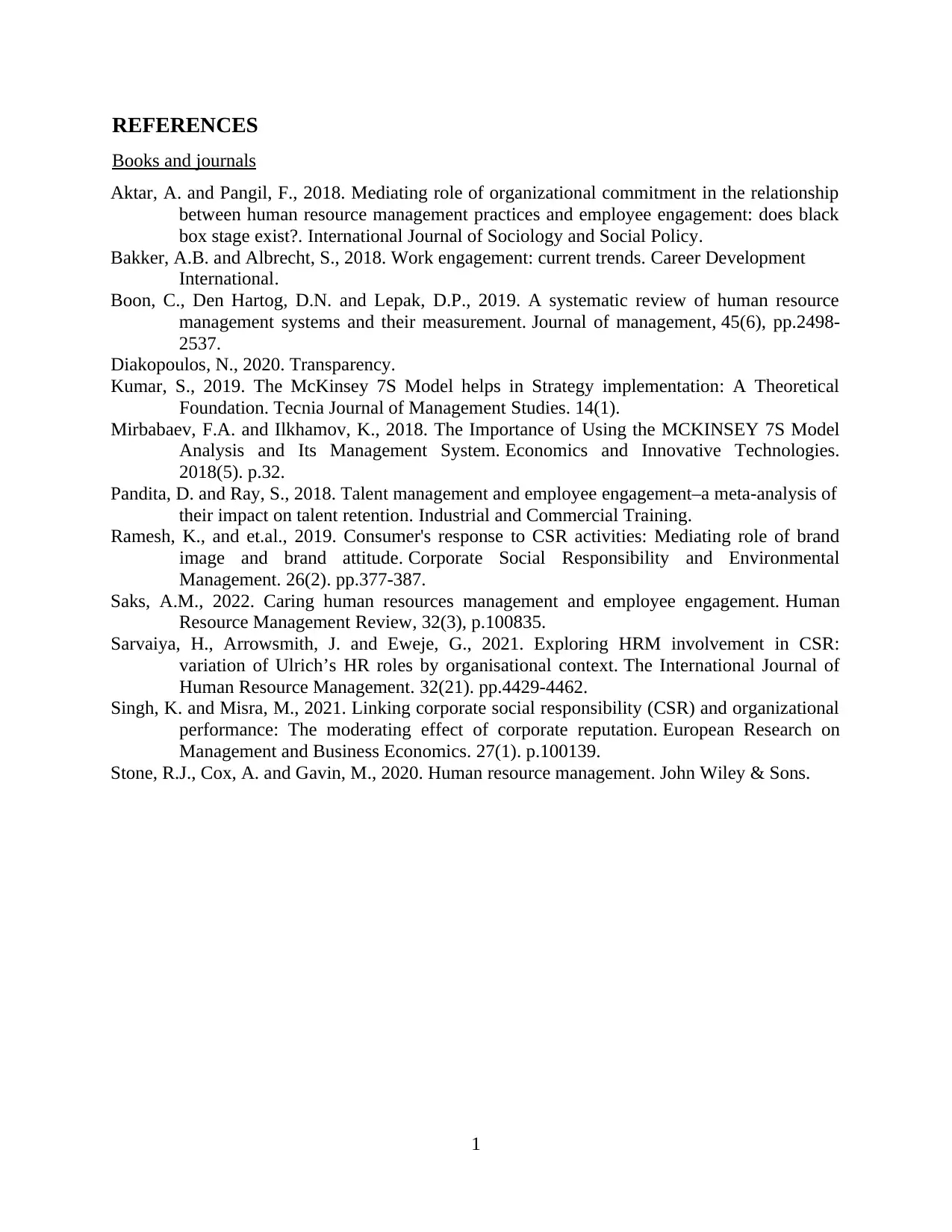
REFERENCES
Books and journals
Aktar, A. and Pangil, F., 2018. Mediating role of organizational commitment in the relationship
between human resource management practices and employee engagement: does black
box stage exist?. International Journal of Sociology and Social Policy.
Bakker, A.B. and Albrecht, S., 2018. Work engagement: current trends. Career Development
International.
Boon, C., Den Hartog, D.N. and Lepak, D.P., 2019. A systematic review of human resource
management systems and their measurement. Journal of management, 45(6), pp.2498-
2537.
Diakopoulos, N., 2020. Transparency.
Kumar, S., 2019. The McKinsey 7S Model helps in Strategy implementation: A Theoretical
Foundation. Tecnia Journal of Management Studies. 14(1).
Mirbabaev, F.A. and Ilkhamov, K., 2018. The Importance of Using the MCKINSEY 7S Model
Analysis and Its Management System. Economics and Innovative Technologies.
2018(5). p.32.
Pandita, D. and Ray, S., 2018. Talent management and employee engagement–a meta-analysis of
their impact on talent retention. Industrial and Commercial Training.
Ramesh, K., and et.al., 2019. Consumer's response to CSR activities: Mediating role of brand
image and brand attitude. Corporate Social Responsibility and Environmental
Management. 26(2). pp.377-387.
Saks, A.M., 2022. Caring human resources management and employee engagement. Human
Resource Management Review, 32(3), p.100835.
Sarvaiya, H., Arrowsmith, J. and Eweje, G., 2021. Exploring HRM involvement in CSR:
variation of Ulrich’s HR roles by organisational context. The International Journal of
Human Resource Management. 32(21). pp.4429-4462.
Singh, K. and Misra, M., 2021. Linking corporate social responsibility (CSR) and organizational
performance: The moderating effect of corporate reputation. European Research on
Management and Business Economics. 27(1). p.100139.
Stone, R.J., Cox, A. and Gavin, M., 2020. Human resource management. John Wiley & Sons.
1
Books and journals
Aktar, A. and Pangil, F., 2018. Mediating role of organizational commitment in the relationship
between human resource management practices and employee engagement: does black
box stage exist?. International Journal of Sociology and Social Policy.
Bakker, A.B. and Albrecht, S., 2018. Work engagement: current trends. Career Development
International.
Boon, C., Den Hartog, D.N. and Lepak, D.P., 2019. A systematic review of human resource
management systems and their measurement. Journal of management, 45(6), pp.2498-
2537.
Diakopoulos, N., 2020. Transparency.
Kumar, S., 2019. The McKinsey 7S Model helps in Strategy implementation: A Theoretical
Foundation. Tecnia Journal of Management Studies. 14(1).
Mirbabaev, F.A. and Ilkhamov, K., 2018. The Importance of Using the MCKINSEY 7S Model
Analysis and Its Management System. Economics and Innovative Technologies.
2018(5). p.32.
Pandita, D. and Ray, S., 2018. Talent management and employee engagement–a meta-analysis of
their impact on talent retention. Industrial and Commercial Training.
Ramesh, K., and et.al., 2019. Consumer's response to CSR activities: Mediating role of brand
image and brand attitude. Corporate Social Responsibility and Environmental
Management. 26(2). pp.377-387.
Saks, A.M., 2022. Caring human resources management and employee engagement. Human
Resource Management Review, 32(3), p.100835.
Sarvaiya, H., Arrowsmith, J. and Eweje, G., 2021. Exploring HRM involvement in CSR:
variation of Ulrich’s HR roles by organisational context. The International Journal of
Human Resource Management. 32(21). pp.4429-4462.
Singh, K. and Misra, M., 2021. Linking corporate social responsibility (CSR) and organizational
performance: The moderating effect of corporate reputation. European Research on
Management and Business Economics. 27(1). p.100139.
Stone, R.J., Cox, A. and Gavin, M., 2020. Human resource management. John Wiley & Sons.
1
1 out of 10
Related Documents
Your All-in-One AI-Powered Toolkit for Academic Success.
+13062052269
info@desklib.com
Available 24*7 on WhatsApp / Email
![[object Object]](/_next/static/media/star-bottom.7253800d.svg)
Unlock your academic potential
Copyright © 2020–2025 A2Z Services. All Rights Reserved. Developed and managed by ZUCOL.





